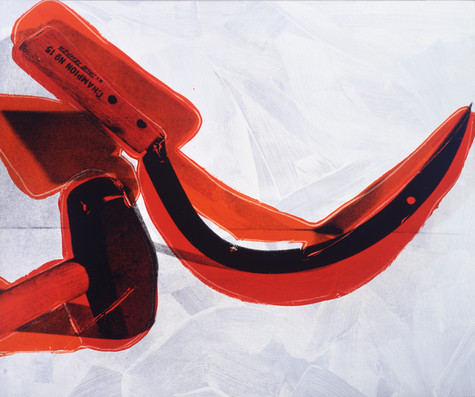The following assessments can be used for this lesson using the downloadable assessment rubric.
- Communication 1
- Communication 2
- Communication 3
- Creative process 1
- Critical thinking 2
- Historical context 3
- Historical context 4

Andy Warhol, Hammer and Sickle, 1976
The Andy Warhol Museum, Pittsburgh; Founding Collection, Contribution The Andy Warhol Foundation for the Visual Arts, Inc. © The Andy Warhol Foundation for the Visual Arts, Inc. 1998.1.186
Andy Warhol created his Hammer and Sickle series in 1976 after a trip to Italy where the most common graffiti in public spaces was this symbol found on Soviet flags. Under communist control, it signified the union of industrial and farm workers’ interests. In Italy, a democratic country since the end of WWII, the repeated graffiti symbol was to Warhol more pop art than political. After returning to the United States, Warhol asked his studio assistant Ronnie Cutrone to find source pictures of this symbol. The reproductions found in books were like the Soviet flag, flat in appearance, and Warhol wanted something different. Cutrone purchased a double-headed hammer and a sickle at a local hardware store and arranged and photographed the tools in many positions. Warhol used the Cutrone photographs for his silkscreened series. In 1977, these works were exhibited under the ambiguous title Still Lifes at the Castelli Gallery in New York City. Warhol disavowed any political ties to his work, though he was aware of the power of symbols and the cultural climate of the Cold War. This war between superpowers, America and the Soviet Union, from the early 1940s through the 1980s was characterized not by actual military combat but by a climate of tension and mutual perceptions of hostility between East and West, communism and capitalism, resulting in the build-up of arms, nuclear weapons, and influence peddling around the globe.
Little did I know that I would also be included on an FBI list, probably for this little art project of ours. I would find myself sneaking along the skyscrapers of the Big Apple and darting into a Red bookstore, looking over my shoulder, I’d find a couple of books and brown-bag them and nonchalantly walk out into the broad daylight. I’d return with the books, heart racing, and Andy would say, half-joking, half-serious, “Were you followed by anybody?” I would answer, “I don’t think so, but if I was, I think I’m a little too old to say I’m a college student studying the Russian Revolution.” Then he’d say, “Did you find any good ones?” I never really did. They were too flat or too graphic. The answer was to go down to Canal Street, into a hardware store, and buy a real hammer and a real sickle. Then I could shoot them, lit with long menacing shadows. And add the drama that was missing from the flat-stenciled book versions. A third dimension of rough outlines would be added and when the paintings were finished they always looked like Amusement Park rides to me. Step right up and ride The Hammer and Sickle. Only 25 cents, if you dare. Not for the weak or faint of heart. It always amused me that Andy the ultimate Capitalist, and me, the ultimate Libertarian, could be suspected of Communist activity.
Warhol’s assistant Ronnie Cutrone, Hammer and Sickle, 2002
Politics cannot be banished entirely from this image, of course. But even if Mr. Warhol is not exactly in the forefront of the international labor movement he can certainly claim the status of an experienced (he is 50 this year) and industrious workman. In these new paintings he has taken something from sculpture (Calder’s stabiles, Claes Oldenburg’s giant variants of household objects), something from architecture (from the towers of San Gimignano to the World Trade Center), and something of painting (spreading the color as a schoolboy spreads jam on his first day at summer camp) and come up with an end‐result that combines imagination with punch.
John Russell, The New York Times, January 21, 1977
Most of the people buying the Soviet paraphernalia were Americans and West Europeans. All would be sickened by the thought of wearing a swastika. None objected, however, to wearing the hammer and sickle on a T-shirt or a hat. It was a minor observation, but sometimes, it is through just such minor observations that a cultural mood is best observed. For here, the lesson could not have been clearer: while the symbol of one mass murder fills us with horror, the symbol of another mass murder makes us laugh.
Anne Applebaum, Gulag, 2003
The punk period witnessed a renaissance of tattooing—a practice which visibly asserts our ritualistic :uncivilized” past and in whose pictorial language the skull looms large. Because of a slew of ‘primitive’ and sexual associations, the tattoo is proscribed by traditional western conventions. But tattoos persist, serving to decorate, seduce, shock, scare, to declare nonconformity . . . [Warhol’s] own tattoo-like exhibitionism at the 1977 opening for his “Hammer and Sickle” paintings drew together various structures of power and pleasure: the art world/gallery system brand of capitalism; a communist emblem rendered in paintings titled Still Lifes, in which the shadow seems more real (threatening) association with leather, homosexuality, and gay rights and aesthetics; disco madness as the latest social marketplace and entertainment industry.
Gary Garrels, Discussions in Contemporary Culture, No. 2, 1989
As a class, discuss students’ descriptions, associations, and interpretations from their grids. On the back of their handout, have students answer the following questions:
The following assessments can be used for this lesson using the downloadable assessment rubric.